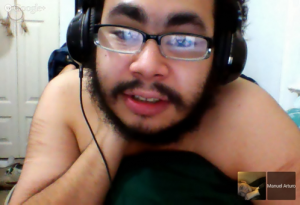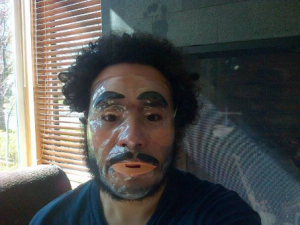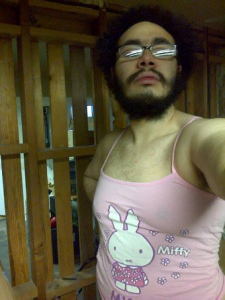Trigger Warning: Descriptions of self harm and body / gender dysphoria.
by manuel arturo abreu
/ /

People say the same thing about selfies that they say about cutting: it’s for attention, it’s a cry for help. Because this makes no sense to me at first glance, and because I engage in both of these, I seek to compare them: can self-mutilation be a kind of selfie on the body, not through the medium of digital images but through the medium of ritualized pain? And can selfies be a kind of self-injury done to one’s idea of one’s body, by exacerbating our latent tendency to confuse bodies with images?
I hide most of my selfies and all of my scars. I do neither for the sake of the gaze of others. They serve as archives of the leakages of my subtle body: cutting through a kind of consubstantiation or something, where I don’t experience blood flowing out but light. Selfies through the curated performance of my body placed into a complex relationship between my intention, the image of my body on the glowing screen, and an imagined or empty audience. Many times this imaginary audience is simply myself in the future, assuming I continue to exist and am, in fact, a cohesive individual entity.
Sometimes I take selfies with the intent to broadcast them. More often than not, one good one arises from every twenty or so. I never, ever cut myself with the intent to broadcast my self-mutilation. In this sense the two rituals are very different. Only once have I broadcast the intent— I consider myself mostly a ‘former’ cutter, but recently ‘relapsed,’ and in the moment of my intent, I called someone in hopes they might come and stop me, but they were unavailable. I carried out my ritual with a more exacting self-awareness than I ever had— something comparable to the self-awareness of my selfie-taking process. Unlike in middle school and high school, I did not listen to music while cutting myself this time. I simply ‘watched’ myself doing it until I didn’t feel that I needed to do it anymore. I patted at the fresh cuts with toilet paper and then decided to paint my nails and drink a beer. I thought about how rare it was that I hurt myself like this anymore. Starving myself is a much less visible means of damaging my body. I prefer this means.

But whether or not my self-injury and selfie-taking are not intended for the gaze of others, I can’t deny that my impulse for both comes from the impact the gaze of others has had on me. As regards the idea that selfies exacerbate our cultural tendency to confuse bodies and images of bodies, I’d derail somewhat with the claim that my understanding of my body is mostly the experience of its sensations mediated through the images I’ve been exposed to.
I was 8 when I started getting tits and puking my dinner and wanting the body of a thin white cis woman.
It didn’t work, I am fat and I have a dick.
/ /
I realize now that my childhood desires to have ‘a woman’s body’ constitute some kind of internalization of the misogynistic logic of images of women’s bodies in American media, but those childhood desires also show my ignorance of the actual experience of womanhood, since (a) the body and genitalia I was thinking of does not categorically belong to ‘women,’ and (b) I flattened experience by thinking I could be the same person if I had a different body. In reality, every shape could lead to a different ontology.
Selfies do not harm me in any physical or psychological sense. I reject the idea that they could be detrimental, because they bring me a significant amount of pleasure and validation — whether as archive or broadcast — in the face of significant body dysmorphia and gender dysphoria. My body has always been built by images from outside me and a medium that allows me to control at least some of the images of a body like mine is a good medium. At least for me. I should recognize that broadcasted selfies, still participate in online attention economies, which I could argue are built on certain normative, oppressive ideas of what beauty is and what is ‘appropriate’ — and certain women have told me that they are resigned to the annoyance of the likelihood that someone, somewhere out there in the online void, is masturbating to at least one of their photos, regardless of whether the photos had any intended sexual element. So, we should note these complexities, while keeping clear a distinction between simply taking selfies for a personal archive versus broadcasting and participating in more normative spheres. While I do not think there is any way the personal selfie archive could cause me harm, I leave open the question of whether broadcasting my selfies might cause me harm, directly or indirectly.

Selfies create a personal archive of images of my body, while cutting ‘writes’ an archive directly on my body, harming me in a physical sense and, to some, perhaps also a psychological sense, though I strongly feel that in times when I feel I need to cut myself, doing so brings my psychological state closer to a normative baseline. That may simply be a justification. Nevertheless, I can compare these two histories and the ways they serve as mediums for exploring ideas about my body. Naturally, selfies allow for a wider domain of exploration, since I take selfies in many different emotional states but tend to cut myself only in one or two specific states. Selfies I have taken in moments of great self-disgust, dysphoria, anxiety, and other ‘negative’ emotions, can be compared to my scars, then, which were enacted in similar, though perhaps more intense versions of these ‘negativities.’
The aspect of play that I believe is ‘built into’ my selfie-taking process — since digital images and the networks one can broadcast them on allow more control of one’s image than a simple mirror — is completely absent from cutting. But neither does cutting seem ‘heavy’ or fraught, except now as I write about it: this prose might be compared in some sense to the broadcasting of selfies, since in setting out to write about cutting, the first thing I face is the stigma normative society has against this behavior, the kind of stigma that would lead people to dismiss it as a cry for attention or help (not to say that it isn’t the latter in some cases), the stigma that leads me to feel that I have to justify my behavior.

As I mentioned, my primary means of damaging my body is starving myself. My weight yo-yos a fair amount. From July 2013 to December 2013 I went from 240 to 170lb. Unlike cutting, which is fairly superficial in its effects on the body and completely hidden by my clothing, starving myself directly engages with the broadcast network of selfies I post online, and more immediately, my physical presence in the world, my gaze enmeshed with the gaze of others. Starving, in a sense, is much more deserving of the critiques people launch against cutting: at least part of wanting to lose weight and be skinnier is my certainty that people around me will treat me better. Of course, I could just eat healthy and exercise, so that’s not only a necessary and not sufficient cause.
I take many more selfies when I feel thin. That’s not to say that feeling thin coincides with starving myself— in fact, when I ‘feel thin,’ it’s more like my dysmorphia is not in ‘full swing’ and I can enjoy being a young body— in these cases eating actually feels nourishing, in the ‘spiritual’ sense, fulfilling some deeper craving than a full stomach, a yearning related to family, and fantasy, and imagination, and love. The selfies I take when I feel thin or normal feel similarly nourishing in the face of my body and gender issues, but they do not actually do as much of the emotional healing work as selfies that I take in more body-negative states of mind—and, as playful as selfie-taking is, this is the predominant mode. I mostly hate my body, feel fat and wrong, and try not to eat anything. I take selfies because it makes me feel a little better, I see a more pixelated and therefore ideal version of myself. I would say cutting myself doesn’t make me ‘feel better,’ it just hurts, and therefore makes me ‘feel.’ If you’ve never had depression that might not make much sense. Think about it this way: depression renders feeling anything impossible. But pain is something like emotion, in that it is direct and has an immediate effect on the body. This kind of simulation, much like the simulation of ‘my body’ that selfies help me curate, can serve to recalibrate my state of my mind, even in some small, useless way.
Anyway, I feel I’ve said enough. I do think a comparison between selfie-taking and self-injury is a fruitful one, but not because the activities are anything alike. Only because they overlap in some senses, and because roughly speaking I use both as ways of understanding myself, strategies of being in a world that I feel does not make any sense. Example: I don’t think causality is provable. I don’t think that every single time I intend to move my finger my finger will move, I don’t think that’s a guarantee at all.

manuel arturo abreu is a poet and artist based in portland who builds strategies of precarious thriving. Read more of their work at twigtech.tumblr and @Deezius.
